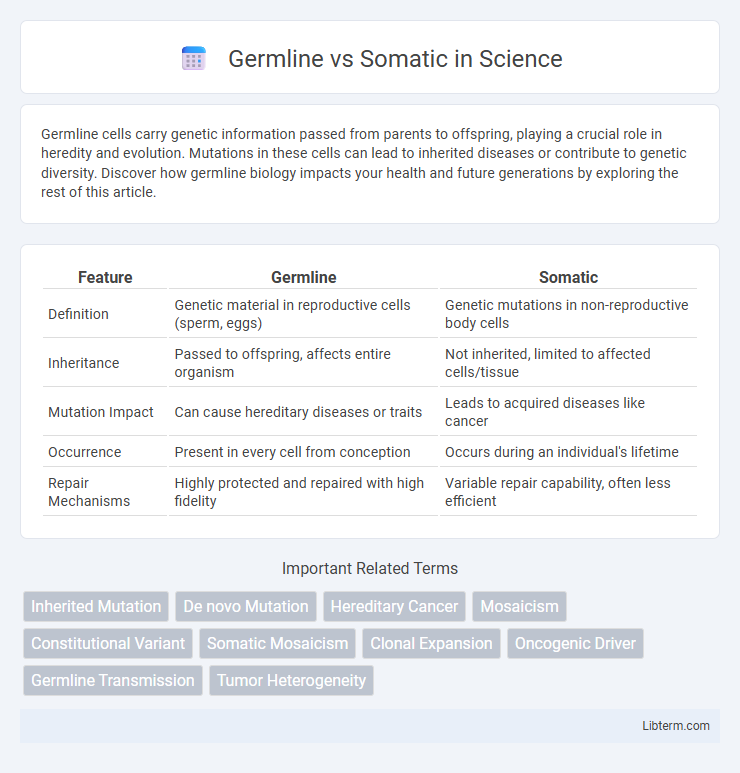Germline cells carry genetic information passed from parents to offspring, playing a crucial role in heredity and evolution. Mutations in these cells can lead to inherited diseases or contribute to genetic diversity. Discover how germline biology impacts your health and future generations by exploring the rest of this article.
Table of Comparison
| Feature | Germline | Somatic |
|---|---|---|
| Definition | Genetic material in reproductive cells (sperm, eggs) | Genetic mutations in non-reproductive body cells |
| Inheritance | Passed to offspring, affects entire organism | Not inherited, limited to affected cells/tissue |
| Mutation Impact | Can cause hereditary diseases or traits | Leads to acquired diseases like cancer |
| Occurrence | Present in every cell from conception | Occurs during an individual's lifetime |
| Repair Mechanisms | Highly protected and repaired with high fidelity | Variable repair capability, often less efficient |
Introduction to Germline and Somatic Cells
Germline cells are reproductive cells that carry genetic information passed from one generation to the next, including sperm and egg cells, while somatic cells constitute all other body cells responsible for forming tissues and organs. Mutations in germline cells are heritable and can affect offspring, whereas somatic cell mutations impact only the individual and are not inherited. Understanding the fundamental differences between germline and somatic cells is crucial for genetics, cancer research, and therapies targeting inherited versus acquired mutations.
Defining Germline Mutations
Germline mutations occur in the reproductive cells and are inheritable across generations, affecting every cell in the organism. These mutations contribute to inherited genetic disorders and play a significant role in evolutionary processes. Unlike somatic mutations, which arise in non-reproductive cells and are not passed to offspring, germline mutations have lasting impacts on lineage and population genetics.
Understanding Somatic Mutations
Somatic mutations occur in non-reproductive cells and are not inherited, affecting only the individual in which they arise. These mutations can result from environmental factors like UV radiation or chemical exposure, potentially leading to diseases such as cancer by altering normal cellular functions. Understanding somatic mutations is crucial for developing targeted therapies and personalized medicine approaches that address the specific genetic changes within affected tissues.
Differences Between Germline and Somatic Mutations
Germline mutations occur in reproductive cells and can be inherited by offspring, affecting every cell in the organism. Somatic mutations arise in non-reproductive cells and are not passed to offspring, typically leading to localized effects such as cancer. The key difference lies in inheritance potential and the scope of impact within the organism's body.
Inheritance Patterns: Germline vs Somatic
Germline mutations occur in reproductive cells and are inherited by offspring, affecting every cell in the body and passed through generations following Mendelian inheritance patterns. Somatic mutations arise in non-reproductive cells and are not inherited; they affect only a subset of cells within an individual, leading to mosaicism or localized disease such as cancer. Understanding the distinction between germline and somatic mutations is crucial for genetic counseling, disease risk assessment, and targeted therapies.
Role in Genetic Diseases
Germline mutations occur in reproductive cells and are inheritable, contributing to genetic diseases passed from parents to offspring, such as cystic fibrosis and Huntington's disease. Somatic mutations arise in non-reproductive cells and are not heritable but can cause diseases like cancer by affecting cellular function and proliferation. Understanding the distinction between germline and somatic mutations is crucial for genetic diagnosis, risk assessment, and targeted therapies in hereditary and acquired conditions.
Impact on Cancer Development
Germline mutations are inherited genetic changes present in every cell that can predispose individuals to cancer by disrupting key tumor suppressor genes or DNA repair mechanisms. Somatic mutations occur in individual cells during a person's lifetime and drive cancer development by causing uncontrolled cell growth and genomic instability. The interplay of germline susceptibility with somatic mutation accumulation significantly influences cancer onset, progression, and therapeutic outcomes.
Detection and Testing Methods
Germline mutation detection primarily relies on genetic testing methods such as blood or saliva DNA analysis, whole-exome sequencing, and targeted gene panels to identify inherited variations present in every cell. Somatic mutation testing utilizes tissue biopsy samples, liquid biopsies, and next-generation sequencing (NGS) technologies to detect acquired mutations confined to tumor cells. Advanced methods like digital droplet PCR and circulating tumor DNA (ctDNA) analysis enhance sensitivity in somatic mutation detection, enabling precise cancer diagnosis and treatment monitoring.
Therapeutic Implications
Germline mutations, inherited and present in every cell, pose significant challenges for targeted therapies because they affect all tissues and can lead to hereditary cancers, necessitating preventive approaches like genetic counseling and surveillance. Somatic mutations, confined to specific tissues or tumor cells, enable precision therapies such as targeted inhibitors or immunotherapies that exploit the unique genetic alterations in cancer cells. Understanding the distinction guides personalized treatment plans, improving efficacy by tailoring interventions to mutation type and origin while minimizing systemic side effects.
Future Research Directions
Future research in germline versus somatic mutations aims to enhance precision medicine by identifying mutation-specific therapeutic targets and improving gene-editing techniques like CRISPR to correct pathogenic germline variants without off-target effects. Advancements in single-cell sequencing and bioinformatics will facilitate deeper understanding of somatic mutation heterogeneity in cancer, enabling development of personalized treatments and early detection biomarkers. Integration of multi-omics data and longitudinal studies is expected to elucidate mutation dynamics, guiding innovative interventions for hereditary and sporadic diseases.
Germline Infographic

 libterm.com
libterm.com